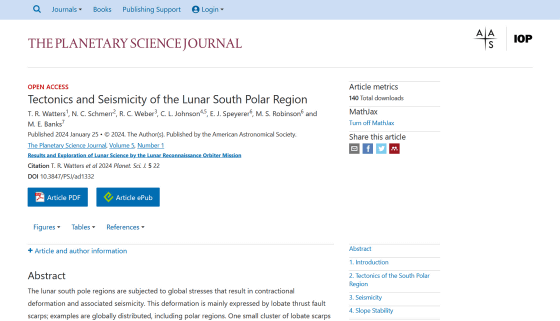'Moonquakes' caused by the cooling and contraction of the moon may have a negative impact on the Artemis project and the construction of lunar colonies

by
Although the current moon does not experience active volcanic activity or plate movement like the Earth, it is known that moonquakes occur due to crustal deformation due to surface contraction. A new study has shown that there is a fault near the moon's south pole that causes large-scale moonquakes, which could affect NASA's Artemis mission and the construction of lunar colonies.
Tectonics and Seismicity of the Lunar South Polar Region - IOPscience
https://iopscience.iop.org/article/10.3847/PSJ/ad1332

The Moon is Shrinking, Causing Landslides and Instability in Lunar South Pole | College of Computer, Mathematical, and Natural Sciences | University of Maryland
https://cmns.umd.edu/news-events/news/Nicholas-Schmerr-moon-shrinking-causing-landslides-and-instability-lunar-south-pole
Our shrinking moon could cause moonquakes near Artemis astronauts' landing site, scientists warn | Space
https://www.space.com/shrinking-moon-artemis-astronauts-landing-site
The interior of the moon has cooled down over the past hundreds of millions of years, causing the surface to wrinkle and shrink like a ``dried raisin.'' The supple skin of a grape forms wrinkles, but the moon's fragile surface causes faults to form, and these faults are known to cause crustal movements such as moonquakes.
In the Apollo program of the 1970s, moonquake observation was carried out over a long period of time using seismometers installed on the moon, and 12,558 moonquakes were observed during the observation period of more than 8 years. Moonquakes take a long time to reach their peak, sometimes lasting for tens of minutes to several hours, and some moonquakes have reached a magnitude of 5 on Earth.
The strongest moonquake observed by the Apollo seismometer occurred on March 13, 1973, in the Antarctic region. A team of researchers from NASA, the Smithsonian Institution and others predicted the epicenter of this earthquake using a relocation algorithm specialized for sparse seismic networks. As a result, it was found that large-scale moonquakes are likely to occur near the South Pole, which NASA has selected as a landing site for the Artemis program .
The figure below shows the hypocenter candidate site predicted by the algorithm in dark pink, and the area indicated by the light blue box is the landing candidate site of the Artemis project. The area near the moon's south pole is thought to be rich in ice and other resources, making it an attractive exploration target, but the shaking caused by strong moonquakes and accompanying landslides could pose a danger to astronauts. There is also gender. In fact, the research team's model suggests that the walls of Shackleton Crater , which are expected to contain ice reserves, are vulnerable to landslides.

'You can think of the moon's surface as a dry, gravelly, dusty mess that has been there for billions of years,' said study co-author
The research team continues to map moonquake activity, aiming to further pinpoint areas that are dangerous for human exploration. Knowing dangerous areas on the lunar surface is important for safely proceeding with long-term lunar exploration activities, and is also useful in narrowing down candidate sites for building bases and colonies.
'As the manned Artemis mission approaches its launch date, it is important to keep astronauts, equipment, and infrastructure as safe as possible,' said Schumer. 'It will help us prepare for what awaits us on the moon, including designing new systems and keeping people out of really dangerous zones.'

Related Posts:
in Science, Posted by log1h_ik







